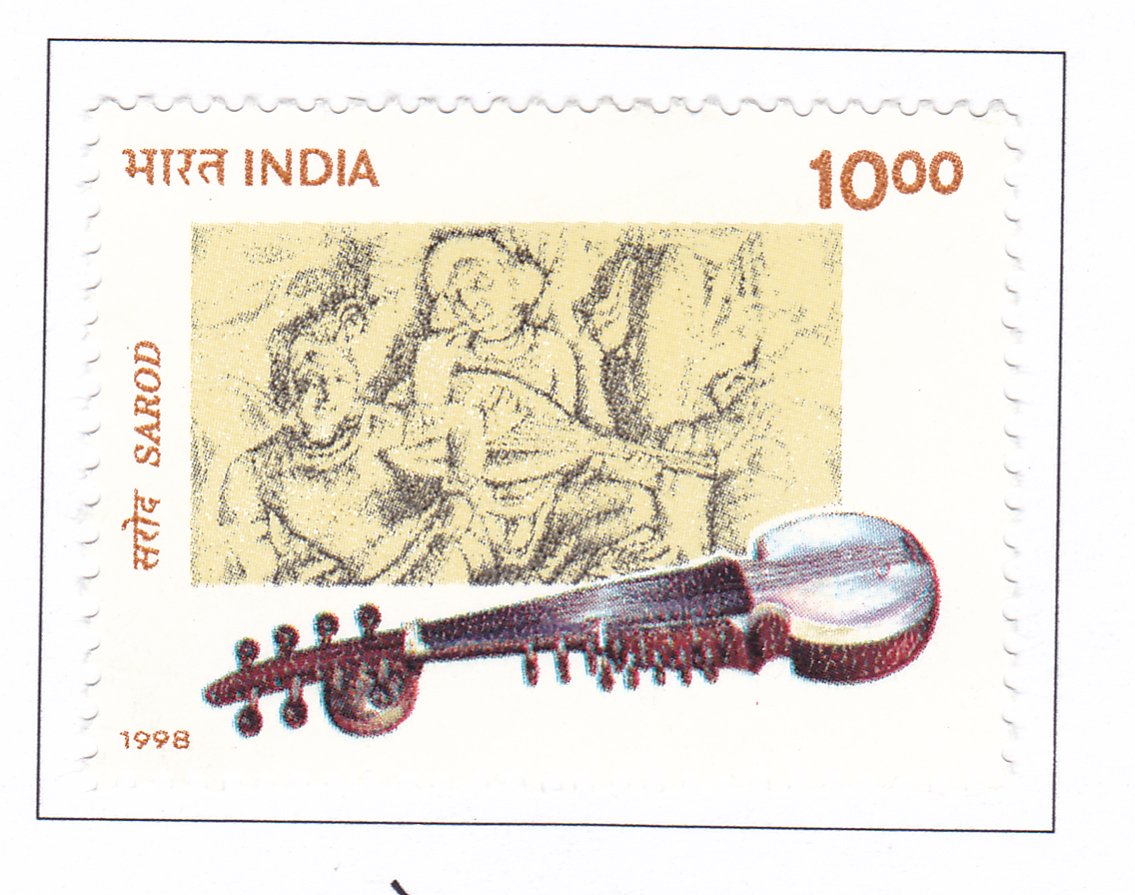Sarod (stringed instrument)

Technical Data
| Stamp Set | Indian Musical Instruments |
|---|---|
| Date of Issue | December 29, 1998 |
| Denomination | Rs. 10 |
| Quantity | 700,000 |
| Perforation | comb 13½ x 13 |
| Printer | Security Printing Press, Nashik |
| Watermark | No Watermark |
| Colors | Multicolor |
| Catalog Codes |
Michel IN 1666 Stamp Number IN 1724 Yvert et Tellier IN 1431 Stanley Gibbons IN 1829 |
| Themes | Musical Instruments |
Table of Contents
Sarod (Stringed Instrument)
Overview:
The Sarod is a prominent Indian stringed instrument renowned for its rich, deep, and resonant sound. It is a key instrument in Hindustani classical music and is celebrated for its versatility and emotive capabilities.
Characteristics:
- Structure:
- Material: The Sarod is traditionally made from a single block of wood, often from the jackfruit tree or similar hardwood. The body is hollowed out to create a resonating chamber.
- Shape: It has a distinctive, rounded, and slightly elongated shape. The front of the instrument is covered with a membrane made from animal skin, which enhances its tonal quality.
- Strings: The Sarod typically has 25 to 27 strings, including melody strings, drone strings, and sympathetic strings. The melody strings are usually metal, while the sympathetic strings are made of various materials.
- Fingerboard: The instrument features a fretless metal fingerboard, which allows for sliding and smooth transitions between notes.
- Playing Technique:
- Position: The Sarod is played while seated, with the instrument held horizontally. The player rests it on their lap or a stand, depending on their comfort and the performance setting.
- Plectrum: A plectrum or “mizrab” is used to pluck the strings. The mizrab is typically made of metal or bamboo and is held in the right hand.
- Fingering: The left hand presses the strings against the metal fingerboard to produce different notes. The absence of frets allows for subtle variations in pitch and smooth glides between notes.
- Historical Significance:
- Origins: The Sarod is believed to have evolved from earlier Persian instruments, such as the “Rubab.” It gained prominence in India through the influence of the Mughal era and the development of classical music traditions.
- Role in Music: The Sarod is integral to the performance of classical ragas in Hindustani music. It is known for its ability to produce a wide range of tonal colors and expressive nuances.
- Cultural Importance:
- Symbolism: The Sarod represents the rich heritage of Indian classical music and is often associated with meditative and soulful musical expressions.
- Educational Value: Mastery of the Sarod involves rigorous training and deep understanding of ragas and rhythm. It is an important instrument for students of Indian classical music, offering insights into musical aesthetics and techniques.
Commemorative Stamp Design:
- Visual Elements: The stamp showcasing the Sarod would highlight its elegant and intricate design, including the detailed carving on the wooden body and the metal fingerboard. The instrument’s strings and mizrab would also be depicted to emphasize its playing technique.
- Background: The background might feature traditional musical settings, such as a classical music performance or a serene Indian landscape, to place the Sarod in its cultural context.
Educational Value:
- Understanding Tradition: The stamp educates the public about the Sarod’s role in Indian classical music and its historical development.
- Promoting Heritage: By commemorating the Sarod, the stamp celebrates the instrument’s contribution to India’s musical heritage and encourages appreciation for classical music traditions.
The Sarod stamp serves as a tribute to this remarkable instrument, highlighting its significance in the realm of Indian classical music and its enduring cultural legacy.
